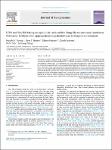




The Sm/Nd isochron mineral dating technique, applied on lenses of ophiolitic rocks of the Song Ma suture zone, reveals crystallization ages of 387–313 Ma for titanites extracted from the mafic components (metagabbros, metabasalts) of the ophiolite suite. These ages correspond to a large time interval within the Carboniferous period. Such results mean that these blocks are lithospheric relics of an eastern branch of the Paleotethys. They however do not exclude that an older early Paleozoic ocean has previously existed in the area. The overprinted metamorphism that affect these rocks and the metasedimentary host rocks, including locally HP granulite and eclogite facies conditions (Nakano et al., 2006, 2008, 2010), took place during the Triassic Indosinian orogeny after closure of the ocean, continental subduction and collision, leading to the suturing of the Indochina and South China blocks. U/Pb and Ar/Ar data reveal that peak metamorphic conditions were attained 266–265 Ma ago, being then followed by cooling at 250–245 Ma.
Bản đồ thống kê
Thống kê nội dung


The Sm/Nd isochron mineral dating technique, applied on lenses of ophiolitic rocks of the Song Ma suture zone, reveals crystallization ages of 387–313 Ma for titanites extracted from the mafic components (metagabbros, metabasalts) of the ophiolite suite. These ages correspond to a large time interval within the Carboniferous period. Such results mean that these blocks are lithospheric relics of an eastern branch of the Paleotethys. They however do not exclude that an older early Paleozoic ocean has previously existed in the area. The overprinted metamorphism that affect these rocks and the metasedimentary host rocks, including locally HP granulite and eclogite facies conditions (Nakano et al., 2006, 2008, 2010), took place during the Triassic Indosinian orogeny after closure of the ocean, continental subduction and collision, leading to the suturing of the Indochina and South China blocks. U/Pb and Ar/Ar data reveal that peak metamorphic conditions were attained 266–265 Ma ago, being then followed by cooling at 250–245 Ma.